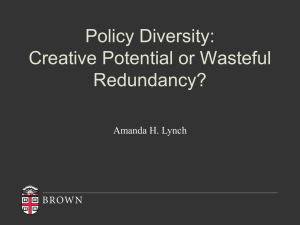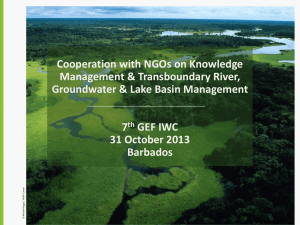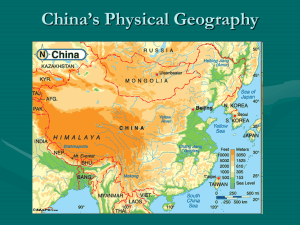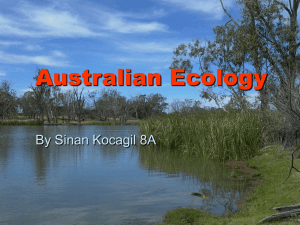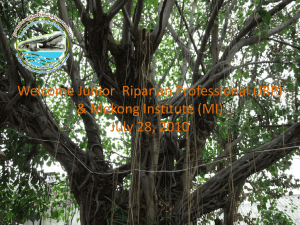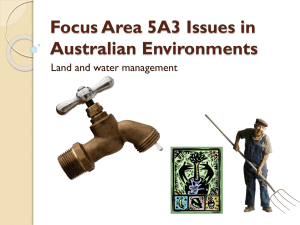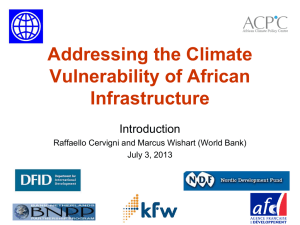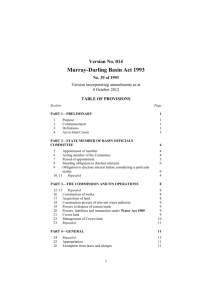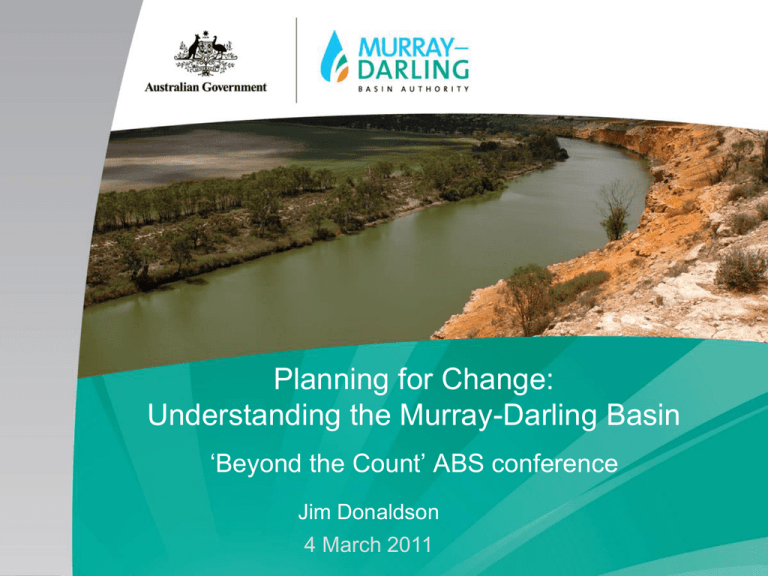
Planning for Change:
Understanding the Murray-Darling Basin
‘Beyond the Count’ ABS conference
Jim Donaldson
4 March 2011
Aim of presentation
• To provide a taste of how Census
data has been used to make a
difference in water resource planning
in the Murray-Darling Basin
– discuss some of the challenges
involved: policy and information
The Murray-Darling Basin
The Murray-Darling Basin
Murray-Darling Basin
• 14% of Australia (size of Spain & France)
• Directly supports 3 million people
• Feeds approximately 20 million people
• Significant environmental values
• Australia’s three longest rivers
• 40% Australia’s farmers
• Gross value of agricultural production $15b (40%
Australia) – irrigation: $5.5b (15%)
• Agricultural exports earn $9b/year
• Home to 34 major Indigenous groups
Hydrology of the Basin
7
Growth in Basin diversions
12,000
10,000
GL/year
8,000
6,000
4,000
2,000
0
1930
1940
1950
1960
1970
1980
1990
2000
8
Consumptive water use
8,000
7,000
6,000
5,000
GL
4,000
3,000
2,000
1,000
0
Agriculture
Mining
Manufacturing Other
Households Water supply
industries
industry
Current Trend
Total Water (GL)
Water Use (GL)
Historical Climate
23,417
11,327 (48%)
2030 Median Climate
20,936
10,876 (52%)
2030 Dry Extreme
15,524
8,962 (58%)
(CSIRO Water Availability – 2008)
Ecosystem Health Assessments by Valley, 2004-07
The need for water reform
• Return extraction of water to a more
sustainable level
• Support ecological health of the Basin
• Build a more certain future for communities
• Sustain economic output over long term
• Manage water resources for future generations
12
Building on past reform
1901
Constitution
2010
Guide to the
proposed
Basin Plan
1914
River Murray
Commission
2008
COAG
Agreement
1987
Murray-Darling
Basin
Commission
2007 Water Act
&
Murray-Darling
Basin Authority
1990’s
Cap on
Diversions &
Water markets
2004
National Water
Initiative
&
The Living
Murray
13
What’s the issue?
• Rebalancing water use in the MDB
– What’s the right balance?
• Trade-offs: optimise economic, social
and environmental outcomes
– Measuring the benefits and the costs
– Water Act sets environmental thresholds
The planning process
How much additional
water does the
environment need?
What are the
potential impacts on
the community?
What are the
sustainable diversion
limit proposals?
How to manage the
transition?
15
What we were asked to do
• Describe social and economic
circumstances of Basin communities
dependent on Basin water resources
• Assess the likely economic and
social implications of setting SDLs
and developing the Basin Plan
– Inform setting of SDLs: OPTIMISE outcomes
– Report on implications to government
Socio-economic assessments
16 studies undertaken:
• Baseline socio-economic circumstances**
• Review of structural adjustment pressures
• Economic modelling and analysis
• Local community profiles and assessments
• Indicators of community vulnerability**
• Effects of SDLs on Indigenous people
• Assessment of benefits
• Responses of financial institutions to changes
• Cost benefit analysis
17
Socio-economic context report
• Description of
Basin communities
• Baseline
• Data store
• Community profiles
• Monitoring and
evaluation
Rural population trends
Percent of population living outside the State capital city,
for Murray-Darling Basin states (1901 - 2006)
90
80
Percent of State population
70
60
50
NSW
40
Vic.
Qld
SA
30
20
10
0
1901
1911
1921
1931
1941
1951
1961
Year
Source: ABS Australian Historical Population Statistics, cat. no. 3105.0.65.001
1971
1981
1991
2001
2006
Population Projections - Basin
Population trends 2001-06
Per cent
Per cent
20
20
10
10
0
0
-10
-10
-20
-20
-30
-30
-40
-40
-50
-50
Major cities
Inner regional
Outer regional
Remote
Very remote
Population change by region
Population change, 2001-2006, Sustainable Yield Regions
Barw on-Darling
Paroo
Warrego
Gw ydir
Moonie
Wimmera
Lachlan
Namoi
Macquarie-Castlereagh
Border Rivers
Loddon-Avoca
Ovens
Murray
Goulburn-Broken
Murrumbidgee
Condamine-Balonne
Campaspe
East Mt Lofty Ranges
-15.0
-10.0
-5.0
0.0
Source: ABS Estimated Resident Population, data available on request
5.0
10.0
15.0
20.0
(%)
Indigenous population change
Population change 2006 - 2001, by Indigenous status and remoteness,
Murray-Darling Basin
Total Murray-Darling Basin
Very Remote
Remote
Outer Regional
Inner Regional
Canberra
-40
-30
-20
-10
0
10
20
30
Percent Change (%)
Source: ABS Census of population and housing 2006 and 2001
Non-Indigenous population
Indigenous population
Population Age by Sex
Employment 2001-06
Persons employed
Persons employed
180,000
150,000
180,000
2001
2006
150,000
120,000
120,000
90,000
90,000
60,000
60,000
30,000
30,000
0
0
Key trends and messages
•
•
•
•
•
Population is growing in the Basin
There is a shift from remote to urban
Employment in the Basin is growing
Young working population declining
However, employment in agriculture
is declining
– Provides some baseline data …
Analysing impacts on community
• Impact of different water reductions
• Impact of reductions on different
farming sectors
• Off-farm or flow-on impacts (to
business and community)
• Impact of reduction at Basin and
regional scales
27
Reports
Community vulnerability
• Project on ‘Indicators of community
vulnerability and adaptive capacity
across the Murray-Darling Basin’
• Undertaken by ABARES
What is ‘community vulnerability’?
• Vulnerability: the degree to which a
community is susceptible to pressures and
disturbances, such as climate change or
socio-economic processes
• The key questions:
– Who is more vulnerable?
– Why are particular populations vulnerable?
– How do the vulnerabilities of regions compare?
… to reductions in water availability for
consumptive purposes across the Basin
Vulnerability and its components
Potential Impact
Vulnerability
The project approach
• Composite indices - a widely accepted method
for developing socio-economic indicators to
measure change
• Based on a review of the literature related to
indicator development using variables from
census data sets
• These variables were theoretically derived and
statistically verified to represent the constructs
being measured
Criteria for indicator development
Parameters
Output capability
What was used
Scale
• Census Collection Districts (CCDs)
and Statistical Local Areas (SLAs)
• Basin and sub-regions
• Can be concorded, aggregated and
disaggregated to desired scale
Data
sources
• Comparable and
reliable data that can
be used to develop
meaningful indicators
of the constructs
• ABS Census of Population and
Housing
• ABS Agricultural Census
• Comparable with past
and future data
collections
• 2006 Census data
Timescale
Sensitivity
• a measure of how dependent a community is upon the
resource that is changing – e.g. irrigation water
Indicators
Volume of irrigation
water applied on farms
Components
Water
dependence
% Agricultural
businesses irrigating
Farm employment
Agricultural processing
and downstream
employment
Sub-index
Sensitivity
Local economy
agricultural
dependence
Adaptive capacity
• Ability or potential of a community to adapt or change its
characteristics or behaviour to cope better with change
Indicators
Economic diversity
index
Education levels
Housing
Income
Employment
Age structure
Mobility
Volunteering rates
Women in non-routine
jobs
Components
Sub-index
Local economic
diversity
Human capital
Social capital
Adaptive
Capacity
Community vulnerability
Sub-index
Composite index
Sensitivity
Vulnerability
Adaptive
capacity
• The degree to which a community is susceptible to
pressures and disturbances, such as climate change or
socio-economic processes
Community vulnerability
Murrumbidgee vulnerability
Murrumbidgee sensitivity
Murrumbidgee land use
Why is Coleambally more sensitive?
Coleambally
Very high proportion of
agricultural businesses
irrigating
Moderate proportion of
persons employed in
agriculture and
downstream agriindustries
Griffith
High level of agricultural
businesses irrigating
Low proportion of
employment in agriculture
and downstream agriindustries
Murrumbidgee adaptive capacity
Why is Coleambally less adaptive?
Coleambally
Economic diversity
Low economic diversity
Human capital
Low level of unemployment
Low proportion of single parent families
Low proportion of persons aged over 65
Moderate proportion of persons aged 15
years and over with no post secondary
school qualification
Low level of rented properties
Social capital
Low proportion of people volunteering
Moderate proportion of women in nonroutine occupations
Griffith
Economic diversity
High economic diversity
Human capital
Moderate level of unemployment
Low proportion of single parent families
Low proportion of persons aged over 65
High proportion of persons aged 15
year and over with no post secondary
school qualification
Low level of rented properties
Social capital
Low proportion of people volunteering
Low proportion of women in non-routine
occupations
Interpreting the output
• Interpret at highest level, highlighting ‘communities’
with high degrees of vulnerability to changes in
water access
• Investigate reasons for differences in community
vulnerability by examining the underlying variables
(e.g. regional comparison example)
• Aggregate results to other ‘geographies’ depending
on scope of analysis
• Establish a baseline measure for monitoring
Economic Modelling
• Modelling of economic implications of
potential reductions in water availability
– Agricultural sector and regional flow-on effects
– Changes in value of irrigated agriculture
– Regional economy impacts (Gross Regional
Product, Employment)
• Data from other sources: e.g. Agricultural
Census and surveys, Water Account
Key messages
• Census data is critical to understand
the structure, dependencies and
changes occurring in communities
• But Census data is insufficient for
analysis of effects of water reform
• This brings challenges in ability to
match and analyse data –
consistency and compatibility
Data issues and challenges
• Prediction is very difficult, especially about
the future! (Niels Bohr)
• Currency of data for use in modelling
– 2006 and 2001 data: challenge of looking
forward when data is already old
• E.g. 2006 a drought year and face of rural Australia
has reportedly changed much in the last 5 years
• Ability to match data from different
sources and aggregate / disgregate
– Economic data, water data, land use data, social data
– E.g. agricultural census / surveys and Pop’n Census
Data issues and challenges
• Ability to cut data flexibly for non-standard
geographies
• Ability to do time series analyses
• Data is often not available at a regional
scale and / or not frequently enough to
meet priority data needs, e.g.
–
–
–
–
Regular agricultural data
Small area wealth data
Water use data at a regional scale
Water practices and behaviour
Thank you
• ABS
• ABARES
• Particular thanks to Nyree Stenekes
from ABARES for information on
indicators of community vulnerability
• MDBA team
www.mdba.gov.au

